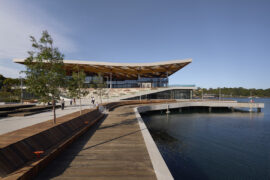A new book investigates the religious architecture of Studio Aalto, the Finnish practice that has influenced the work of architects including Glenn Murcutt and Jørn Utzon.

January 22nd, 2024
‘The Religious Architecture of Alvar, Aino and Elissa Aalto’ provides a fascinating, rigorous and at times moving account of the sacred architecture of the famous Finnish practice. Published by Lund Humphries, the book is written by Dr Sofia Singler, Assistant Professor of Architecture at Cambridge and a Fellow of St John’s College, Cambridge, where she teaches and researches modern architecture. Dr Singler has collaborated with the Alvar Aalto Museum in Finland for more than a decade and previously held the Edward P. Bass Scholarship at the Yale School of Architecture and a Gates Trust Doctoral Scholarship at Cambridge, having also trained as both an architect and an architectural historian.

Finnish architect, Alvar Aalto (1898-1976), is of course a highly prominent figure in twentieth-century architecture and the history of modernism. This book, however, seeks to cover new critical ground with a reappraisal of the significance and influences upon the religious work of his studio. The emphasis on the studio rather than the individual is indeed a key – and welcome – point stressed early in the book by the author.
The new critical ground centres on an argument that refutes Studio Aalto’s religious architecture as merely “artistic opportunism.” It argues that religious influences were significant in relation to Aalto’s modernism – neither wholly determining nor wholly instrumental, but intimately related to it.
Related: Mid-century Metabolism and AI

While the book travels deep into specifically Finnish territory, the questions it raises have strongly universal dimensions for all modern architecture. They recall the debates around Critical Regionalism, and the general dissatisfaction with modernism’s perceived coldness and excessive rationalism.
In the context of something like post-postmodernism, ‘The Religious Architecture of Alvar, Aino and Elissa Aalto’ is a welcome intervention that tackles issues with wide significance through a sustained engagement with specific circumstances. In re-evaluating Aalto’s approach to the sacred, it invites architects and designers to consider modernism in more nuanced light.

The book analyses designs for churches, parish centres, funerary chapels and cemeteries in Finland, Denmark, Germany and Italy. The Church of the Three Crosses (1955–58) in Imatra, Finland is given particular attention as the most famous and architecturally impressive of Aalto’s churches. The author cites it as ultimate evidence of Aalto’s exploitation of the religious brief for the creation of a “sculptural irrationality.”

In order to get to this point, the reader is also taken on a contextual journey through post-Second World War Finland, its politics of borders, urban growth, industrialisation and the Church. A full account is given, for example, of Imatra’s development as an urban centre and how the religious architecture related to other design work there.



At the core of the account of works such as the Church of the Three Crosses is a familiar modernist problem: should a new building, such as a church, place more weight on historical continuity or relevance to the contemporary age? For architectural practitioners and afficionados, this book provides a highly engaging way in to such problems.
Featuring 150 colour illustrations and 55 black-and-white illustrations, ‘The Religious Architecture of Alvar, Aino and Elissa Aalto’ is published by Lund Humphries and available now.
Lund Humphries
lundhumphries.com

We think you might also like this book review of Concrete Jungle on modernism in the tropics.
INDESIGN is on instagram
Follow @indesignlive
A searchable and comprehensive guide for specifying leading products and their suppliers
Keep up to date with the latest and greatest from our industry BFF's!

For those who appreciate form as much as function, Gaggenau’s latest induction innovation delivers sculpted precision and effortless flexibility, disappearing seamlessly into the surface when not in use.

For a closer look behind the creative process, watch this video interview with Sebastian Nash, where he explores the making of King Living’s textile range – from fibre choices to design intent.

Arranged with the assistance of Cult, Marie Kristine Schmidt joins Timothy Alouani-Roby at The Commons in Sydney.

Australia Post’s new Melbourne Support Centre by Hassell showcases circular design, adaptive reuse and a community-focused approach to work.

Signalling a transformative moment for Blackwattle Bay and the redevelopment of Sydney’s harbour foreshore, the newly open Sydney Fish Market demonstrates how thoughtfully designed public realm and contemporary market space can unite to create a landmark urban destination.
The internet never sleeps! Here's the stuff you might have missed

Jason Gibney, winner of the Editor’s Choice Award in 2025 Habitus House of the Year, reflects on how bathroom rituals might just be reshaping Australian design.

CBRE’s new Sydney workplace elevates the working life and celebrates design that is all style and sophistication.